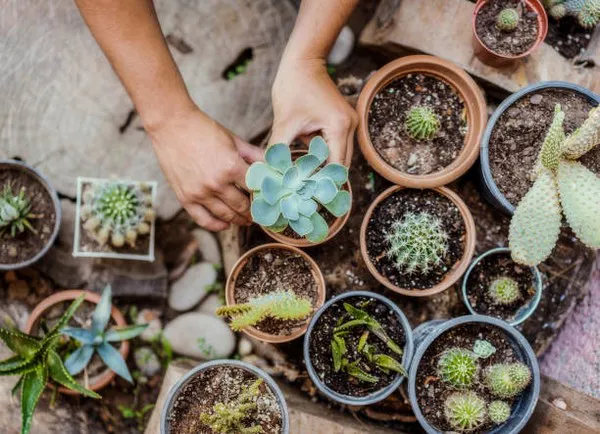Succulents, with their stunning array of shapes, colors, and textures, have surged in popularity among plant enthusiasts. These hardy plants are known for their ability to store water in their leaves, stems, and roots, making them well-suited for various climates and environments. However, like all plants, succulents require proper care and occasional maintenance to thrive. One crucial aspect of succulent care is knowing when to repot them. Repotting ensures that your succulents have adequate space to grow, access to fresh nutrients, and optimal soil conditions. In this comprehensive guide, we’ll explore the telltale signs indicating when it’s time to repot your succulents, along with step-by-step instructions for a successful repotting process.
Understanding Succulent Growth Patterns
Before delving into the specifics of when to repot succulents, it’s essential to understand their growth patterns. Succulents typically grow slowly compared to other plants, which means they may not require repotting as frequently. Additionally, their root systems tend to be shallow but expansive, allowing them to spread out horizontally rather than deeply. This unique growth habit influences the timing and method of repotting.
Signs It’s Time to Repot Your Succulents
1. Overcrowded Container: One of the most obvious signs that your succulent needs repotting is when it outgrows its current container. If you notice roots protruding from the drainage holes or circling around the base of the plant, it’s a clear indication that the plant has become root-bound and requires more space to grow.
2. Slow Growth or Stunted Appearance: Succulents that are struggling to grow or appear stunted despite adequate sunlight and watering may be suffering from restricted root growth. When the roots become cramped within the pot, they are unable to absorb nutrients efficiently, leading to stunted growth. Repotting into a larger container can provide the roots with the space they need to thrive.
3. Depleted Soil Nutrients: Over time, the nutrients in the potting soil can become depleted as the succulent absorbs them for growth. If you notice poor soil drainage, yellowing leaves, or reduced overall vigor in your succulent, it may be a sign that the soil needs refreshing. Repotting allows you to replenish the soil with fresh nutrients, promoting healthier growth.
4. Watering Difficulties: Succulents that require frequent watering despite being planted in well-draining soil may indicate root congestion. When the roots fill the pot entirely, water may struggle to penetrate the soil and reach the root zone effectively. Repotting into a larger container with fresh soil improves water absorption and prevents waterlogged conditions.
5. Seasonal Maintenance: While succulents generally have slower growth rates, they still benefit from occasional repotting to refresh the soil and encourage new growth. As a general rule, consider repotting your succulents every 1-2 years, preferably in the spring or early summer when they enter their active growing phase.
Step-by-Step Guide to Repotting Succulents
Now that you’ve identified the signs indicating that your succulent needs repotting, let’s walk through the process step by step:
1. Choose the Right Container: Select a new container that is slightly larger than the current one, providing ample space for the succulent’s roots to spread. Ensure the new container has drainage holes to prevent waterlogging, which can lead to root rot.
2. Prepare Potting Mix: Use a well-draining potting mix specifically formulated for succulents or cacti. You can also create your own mix by combining equal parts of potting soil, perlite, and coarse sand. Avoid using dense, moisture-retentive soils, as they can suffocate the roots.
3. Gently Remove the Succulent: Carefully remove the succulent from its current pot by gently squeezing the sides of the container to loosen the soil. If the plant is stubbornly stuck, tap the bottom of the pot or use a blunt tool to loosen the soil without damaging the roots.
4. Inspect the Roots: Take this opportunity to inspect the succulent’s roots for any signs of damage, rot, or pests. Trim away any dead or rotting roots using clean, sharp scissors or pruning shears. Healthy roots are firm and white, while damaged roots may appear brown or mushy.
5. Add Fresh Soil: Place a layer of fresh potting mix at the bottom of the new container, ensuring it’s evenly distributed. Position the succulent in the center of the pot, making sure the roots are spread out and not cramped. Add more soil around the roots, gently pressing it down to secure the plant in place.
6. Watering and Settling: After repotting, give the succulent a thorough watering to help settle the soil and eliminate air pockets around the roots. Allow any excess water to drain away completely before placing the pot in its desired location.
7. Monitor and Care: Once repotted, monitor the succulent closely for the first few weeks to ensure it adjusts well to its new environment. Avoid direct sunlight or intense heat during this time, as the plant may be more susceptible to stress. Resume regular watering and maintenance routines once the succulent shows signs of new growth.
Conclusion
Knowing when to repot your succulents is essential for maintaining their health and vitality. By recognizing the signs of overcrowding, nutrient depletion, and root congestion, you can provide your succulents with the space and resources they need to thrive. Follow the step-by-step guide outlined in this article to repot your succulents successfully, ensuring they continue to grace your home or garden with their beauty for years to come. Remember, a well-tended succulent is a happy succulent!


